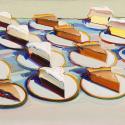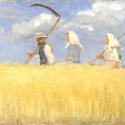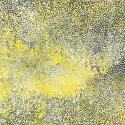Yinka Shonibare’s Serpentine Gallery exhibition opens with a piece of cloth twirling in the breeze; except that it’s a bronze sculpture probably weighing a ton or more – such is the power of art (pictured below right: detail of Wind Sculpture IV, 2024 with African Bird Magic, 2023).
And metaphorically speaking, this is the airiest piece on show. Other works address weighty and contested subject matter, but with such beauty and lightness of touch that you never feel preached at or pulverised with guilt.
Take The War Library 2024, for instance (pictured below: detail). Gallery 2 has been turned into an archive of books on wars and treaties, many of which you’ll probably never have heard of – the Cherokee Uprising, Coto War, Afghan Civil War, Treaty of Zara, Portuguese Conquest of Banda Oriental and, most tellingly, the Second Arab/Israeli War. And in anticipation of future conflicts, some tomes have yet to be titled.
 This catalogue of slaughter is made palatable by the beauty of the installation. The books are covered in the gaily printed cottons familiar to Shonibare from his youth in Lagos. When he discovered that, far from being African in origin, the fabrics were inspired by Indonesian textiles and produced by a Dutch company for export to Africa, he seized on them as symbols of the complexity of relationships between Europe and its former colonies.
This catalogue of slaughter is made palatable by the beauty of the installation. The books are covered in the gaily printed cottons familiar to Shonibare from his youth in Lagos. When he discovered that, far from being African in origin, the fabrics were inspired by Indonesian textiles and produced by a Dutch company for export to Africa, he seized on them as symbols of the complexity of relationships between Europe and its former colonies.
The installation is, then, a bitter-sweet embrace of the paradoxical nature of humanity. The bindings are a reminder that most wars, no matter how prettily they are dressed up, are about power, money and access to resources. And while chronicling the murderous aspect of our species, the work is also a celebration of the redemptive qualities of creativity and imagination.
"Magical" is not a word I often use, but Sanctuary City is just that. The darkened central space is filled with exquisite little models of buildings such as temples, cathedrals and refuges that, traditionally, have provided safety for fugitives and other vulnerable people. Lit from within, these empty spaces are like little beacons of hope in a world that is frequently indifferent to the powerless.
Shonibare is quick to respond to issues of the day. As the argument raged over what to do with statues honouring men with murderous pasts, he began making Decolonised Structures (main picture). Figures like Clive of India and Sir Charles Napier, who between them were responsible for the deaths of millions, have been taken off their pedestals, reduced in scale and decorated with textile patterns that, rather like being tarred and feathered, signify their cruelty and the hypocrisy on which their fame was built. Napier, at least, was honest about his motives. “We have no right to seize Sind, yet we shall do so and a very advantageous… piece of rascality it will be,” he wrote. “Our object in conquering India, the object of all our cruelties was money.”![The War Library, 2024 [detail]. Courtesy Yinka Shonibare CBE and Goodman Gallery, Cape Town, Johannesburg, London and New York; James Cohan Gallery, New York; and Stephen Friedman Gallery, London and New York. Photo: © Stephen White & Co. The War Library, 2024 [detail]. Courtesy Yinka Shonibare CBE and Goodman Gallery, Cape Town, Johannesburg, London and New York; James Cohan Gallery, New York; and Stephen Friedman Gallery, London and New York. Photo: © Stephen White & Co.](/sites/default/files/images/stories/ART/Sarah_Kent/Yinke%20Library-15%20%282%29.jpg) But the use of wax-printed fabrics to symbolise colonial exploitation has become something of a trade mark and its impact is wearing thin. In African Bird Magic 2023, though (pictured above right), Shonibare switches to exquisitely coloured silks. Stitched into a subtle representation of the Mauritius Fody and Comoro Blue Vanga – African birds that face extinction – the piece witnesses the effects of the degradation of the environment. Above the birds hovers an African mask, symbolising the accompanying erosion of cultural traditions. Innumerable threads hang from the seams; they are almost like tears being shed over the loss of so many natural and cultural riches.
But the use of wax-printed fabrics to symbolise colonial exploitation has become something of a trade mark and its impact is wearing thin. In African Bird Magic 2023, though (pictured above right), Shonibare switches to exquisitely coloured silks. Stitched into a subtle representation of the Mauritius Fody and Comoro Blue Vanga – African birds that face extinction – the piece witnesses the effects of the degradation of the environment. Above the birds hovers an African mask, symbolising the accompanying erosion of cultural traditions. Innumerable threads hang from the seams; they are almost like tears being shed over the loss of so many natural and cultural riches.
- Yinka Shonibare: Suspended States at the Serpentine Gallery until September 1
- More visual arts reviews on theartsdesk









![SEX MONEY RACE RELIGION [2016] by Gilbert and George. Installation shot of Gilbert & George 21ST CENTURY PICTURES Hayward Gallery](/sites/default/files/styles/thumbnail_125_x_125_/public/mastimages/Gilbert%20%26%20George_%2021ST%20CENTURY%20PICTURES.%20SEX%20MONEY%20RACE%20RELIGION%20%5B2016%5D.%20Photo_%20Mark%20Blower.%20Courtesy%20of%20the%20Gilbert%20%26%20George%20and%20the%20Hayward%20Gallery._0.jpg?itok=3oW-Y84i)





Add comment